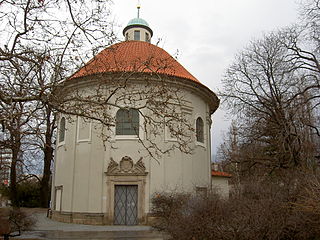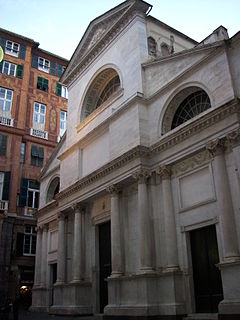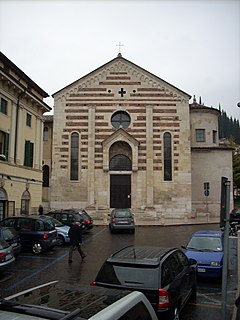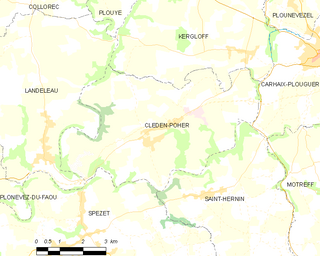
The Piazza dei Miracoli, formally known as Piazza del Duomo, is a walled 8.87-hectare area located in Pisa, Tuscany, Italy, recognized as an important centre of European medieval art and one of the finest architectural complexes in the world. Considered sacred by the Catholic Church, its owner, the square is dominated by four great religious edifices: the Pisa Cathedral, the Pisa Baptistry, the Campanile, and the Camposanto Monumentale. Partly paved and partly grassed, the Piazza dei Miracoli is also the site of the Ospedale Nuovo di Santo Spirito, which houses the Sinopias Museum and the Cathedral Museum.

San Miniato al Monte is a basilica in Florence, central Italy, standing atop one of the highest points in the city. It has been described as one of the finest Romanesque structures in Tuscany and one of the most scenic churches in Italy. There is an adjoining Olivetan monastery, seen to the right of the basilica when ascending the stairs.

The Basilica of Saint Francis of Assisi is the mother church of the Roman Catholic Order of Friars Minor Conventual in Assisi, a town in the Umbria region in central Italy, where Saint Francis was born and died. It is a Papal minor basilica and one of the most important places of Christian pilgrimage in Italy. With its accompanying friary, Sacro Convento, the basilica is a distinctive landmark to those approaching Assisi. It has been a UNESCO World Heritage Site since 2000.

Giulio Campi was an Italian painter and architect. His brothers Vincenzo Campi and Antonio Campi were also renowned painters.

Acqui Terme is a city and comune in the province of Alessandria, Piedmont, northern Italy. It is about 35 kilometres (22 mi) south-southwest of Alessandria. It is one of the principal winemaking communes of the Italian DOCG wine Brachetto d'Acqui.

Cremona Cathedral, dedicated to the Assumption of the Blessed Virgin Mary, is a Catholic cathedral in Cremona, Lombardy, northern Italy. It is the seat of the Bishop of Cremona. Its bell tower is the famous Torrazzo, symbol of the city and tallest pre-modern tower in Italy.

Archon is a commune in the department of Aisne in the Hauts-de-France region of northern France.

The Campo Santo, also known as Camposanto Monumentale or Camposanto Vecchio, is a historical edifice at the northern edge of the Cathedral Square in Pisa, Italy.

Bieliny is a village in Kielce County, Świętokrzyskie Voivodeship, in south-central Poland. It is the seat of the gmina called Gmina Bieliny. It lies approximately 21 km (13 mi) east of the regional capital Kielce. Bieliny is near the highest peaks of the Świętokrzyskie Mountains - Łysica, Agata and Łysa Góra.

San Michele is a Romanesque-style, Roman Catholic church located in the city of Cremona, region of Lombardy, Italy.

The Church of Saint Roch, located on Olšany Square, is the oldest church in present-day Žižkov, a cadastral district of Prague, Czech Republic. The Baroque structure was built between 1680 and 1682 by Jan Hainric, probably according to plans by the renowned French architect Jean Baptiste Mathey.

The Abbey of Santa Maria di Rovegnano is a Cistercian monastic complex in the comune of Milan, Lombardy, northern Italy. The borgo that has developed round the abbey was once an independent commune called Chiaravalle Milanese, now included in Milan and referred to as the Chiaravalle district.

Santa Maria delle Vigne is a Roman Catholic basilica church in Genoa, Italy. It was built in the 10th century. The main altar was completed in 1730 by Giacomo Antonio Ponsonelli. The church is also the final resting place of the leading early Italian composer Alessandro Stradella, who was murdered in 1682.

Santa Maria della Croce is a Roman Catholic sanctuary and minor basilica in Crema, in the Cremona Province of Lombardy, Italy.
The Rotonda della Besana is a late baroque building complex and former cemetery in Milan, Italy, built between 1695 and 1732 and located close to the city center. The complex comprises a lobate hectagonal colonnade portico enclosing a garden and the deconsacrated church of San Michele ai Sepolcri. The portico was designed by architects Francesco Croce and Carlo Raffaello Raffagno, while the church was designed by Attilio Arrigoni. Although originally a cemetery, over time the Rotonda has been adapted for a number of other uses; today, it is a leisure area and a venue for cultural events.

The Basilica of Santa Maria della Sanità is a basilica church located over the Catacombs of San Gaudioso, on a Piazza near where Via Sanità meets Via Teresa degli Scalzi, in the Rione of the Sanità, in Naples, Italy. The church is also called San Vincenzo or San Vincenzo della Sanità, due to the cult of an icon of San Vincenzo Ferrer, also called locally O' Monacone.

Santo Stefano is a Paleo-Christian, Roman Catholic basilica church in central Verona, region of Veneto, Italy.

The Cléden-Poher Parish close comprises the Église Notre-Dame de l'Assomption, a calvary and an ossuary, and is located in the arrondissement of Châteaulin in Finistère in Brittany in north-western France. It is a listed historical monument since 1983.
San Nicolò is a Neoclassical-style, Roman Catholic church located on in the town of Isola Dovarese in the province of Cremona, region of Lombardy, Italy.

San Barnaba is a deconsecrated Baroque-style, Roman Catholic church, located on Corso Magenta #44, near Piazzale Arnaldo, in Brescia, region of Lombardy, Italy. The church in the 20th century became an auditorium and conference hall, and home of the Conservatorio Luca Marenzio.


















